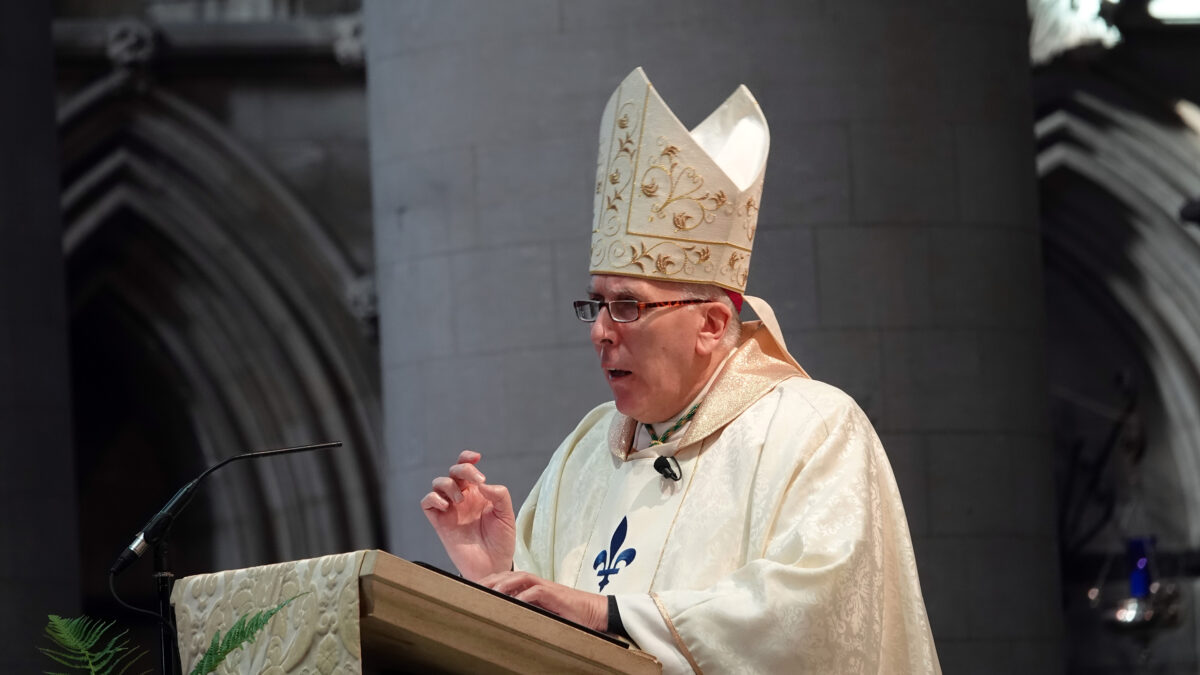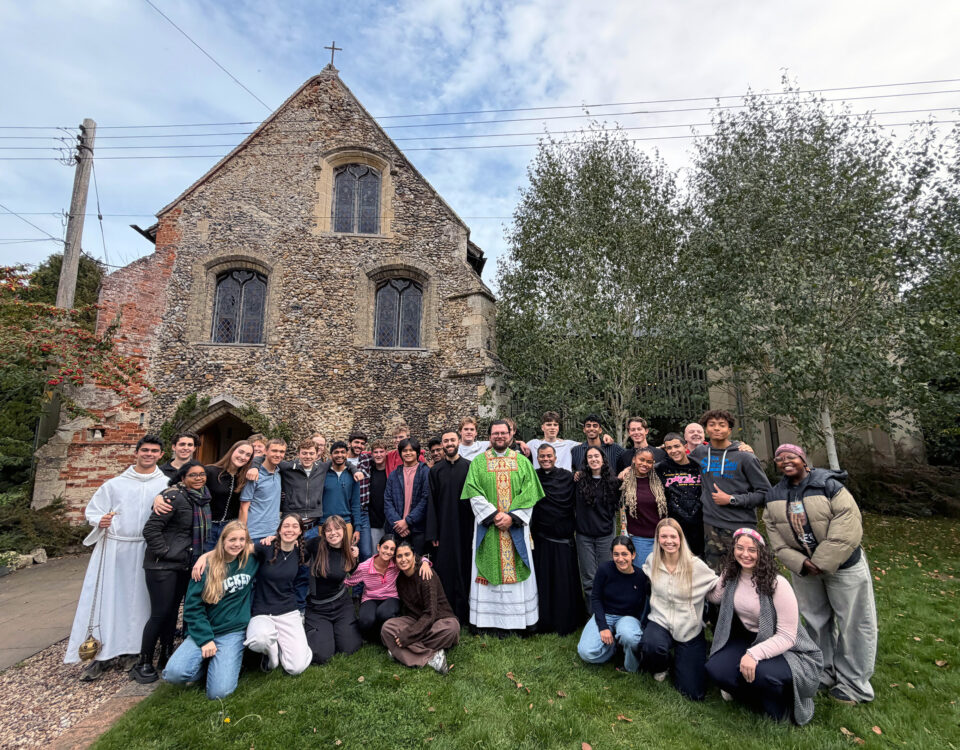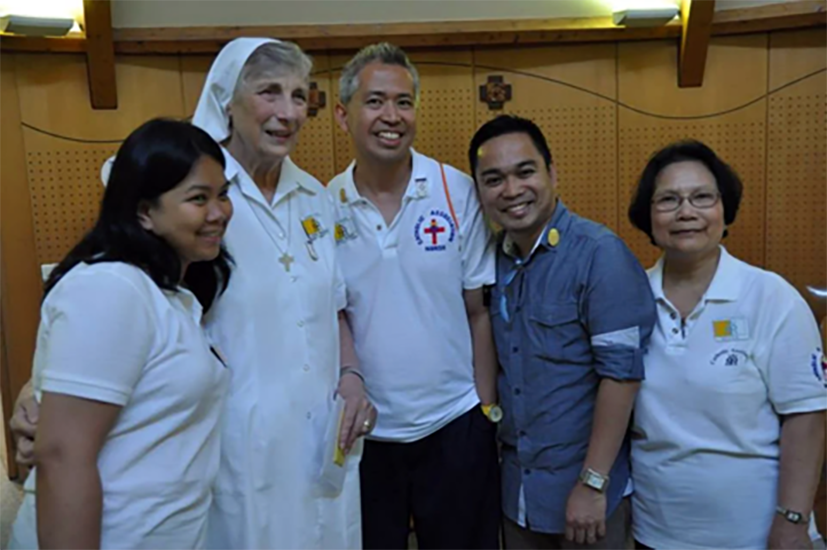
Notre Dame High School Holds Prayer Vigil
August 18, 2025
Major Boost for ‘At Risk’ Church in Peterborough
August 18, 2025Each year, on 15 August, the Church celebrates with great joy the Solemnity of the Assumption of the Blessed Virgin Mary.
This feast is one of the most significant in the liturgical calendar, proclaiming our faith in the victory of Christ over sin and death, and in Mary’s unique share in that triumph. It is a day that lifts our eyes towards heaven, reminding us of the destiny that awaits all who live faithfully in Christ.
The Assumption is not only a celebration of Mary’s role in salvation history, but also a sign of hope for the pilgrim Church today. In a world so often overshadowed by conflict and division, this solemnity calls us back to the humility, obedience, and faith that Mary embodied — virtues that shine as a guiding light for the Christian life.
In his homily for this year’s feast, Bishop Peter Collins reflects on the teaching of the Church, the witness of history, and the challenges of our present age. He invites us to contemplate the mystery of Mary’s Assumption and to draw strength from her Magnificat, a song that proclaims both God’s justice and His mercy.
The full homily is below.
The Solemnity of the Assumption of the Blessed Virgin Mary 2025
Drawing from the Second Vatican Council’s Dogmatic Constitution on the Church – Lumen Gentium – the Catechism of the Catholic Church teaches that the Blessed Virgin Mary is our Mother in the order of grace.
By her complete adherence to the Father’s will, to his Son’s redemptive work, and to every prompting of the Holy Spirit, the Virgin Mary is the Church’s model of faith and charity. Thus she is the ‘pre-eminent’ … and wholly unique member of the Church; indeed, she is the ‘exemplary realisation’ (typus) of the Church.
Her role in relation to the Church and to all humanity goes still further. In a wholly singular way she co-operated by her obedience, faith, hope and burning charity in the Saviour’s work of restoring supernatural life to souls. For this reason she is mother to us in the order of grace.
It was on 1st November 1950 that Pope Pius XII promulgated his solemn definition of the Assumption of the Blessed Virgin Mary through the Apostolic Constitution Munificentissimus Deus.
Pope Pius XII outlined how the dogma was founded in the Scriptures; was proclaimed by the holy Fathers of the Church; was explained and declared by the authentic zeal, knowledge and wisdom of the theologians; was fixed deeply in the hearts and minds of the faithful in Christ; and was approved by ecclesial worship from the earliest times and across the centuries.
The text is worthy of proclamation:
“The august Mother of God, joined in a secret manner with Jesus Christ, from all eternity ‘by one and the same decree’ of predestination, immaculate in her conception, a most pure virgin in her divine maternity, noble ally of the divine Redeemer, who has gained full triumph over sin and its consequences, has finally attained as the highest crown of her privileges, that she should be immune from the corruption of the tomb, and that in the same manner as her Son she would overcome death and be taken away soul and body to the supernal glory of heaven, where as Queen she would shine forth at the right hand of the same Son of hers, the immortal King of ages.”
Pope Pius went on to state:
“We pronounce, declare and define that the dogma was revealed by God, and that the Immaculate Mother of God, the ever Virgin Mary, after completing her course of life upon earth, was assumed to the glory of heaven both in body and soul.”
It is worthy of recollection that this promulgation came just five years after the end of World War II. During the Holy Year of 1950 the solemn definition of the Assumption of the Blessed Virgin Mary represented ‘the great sign’ of the redemption.
Today marks the 80th anniversary of VJ Day. The victory over Japan brought the Second World War to an end.
On this solemnity of the Assumption we rejoice to hear the words of the Magnificat for we behold the humility of Mary: My soul magnifies the Lord. My spirit rejoices in God my Saviour.
The humility of Mary is made manifest in her complete reliance on God’s grace and will. The humility of Mary manifests a definitive contradiction to the self-magnification of all human dictators.
In the Book of Revelation, following the depiction of the ‘seven seals’ and the ‘seven trumpets’, which sequentially depict the eschatological woes, judgement and ultimate salvation of the world, we are presented with a vision:
“And a great sign appeared in heaven: a woman clothed with the sun, with the moon under her feet, and on her head a crown of twelve stars.”
This imagery draws on strands from the Old Testament and we can interpret its application to the context of ancient Israel, but also to the era of the new and eternal covenant, to the life of the Church in Christ: “Now the salvation and the power and the kingdom of our God and the authority of his Christ have come.”
The Church has also, rightly, interpreted the imagery in relation to the Blessed Virgin Mary. To employ the words of Psalm 45: “On your right stands the queen in gold of Ophir.”
Our celebration of the Assumption of the Blessed Virgin Mary manifests our faith in what is proclaimed by St Paul in his first letter to the Corinthians: “Christ must reign until he has put all his enemies under his feet – and the last enemy to be destroyed is death.”
With St Paul we proclaim that God has put all things in subjection under the feet of Christ.
This morning our nation stood in solidarity with His Majesty the King as he visited the National Memorial Arboretum in commemorating VJ Day.
The allied resistance to the oppressing forces of the Empire of Japan in South-East Asia and the Indian Ocean came under the command of Admiral Lord Mountbatten, whilst the Americans led the resistance across the expanse of the Pacific Ocean.
The largest single force under British command during the Second World War was the 14th Army, which drew personnel from the UK and from many Commonwealth countries. Two million soldiers were provided by the Indian sub-continent alone.
One of the most poignant memorials at the National Memorial Arboretum honours the sacrifice of those who were so cruelly forced to work on the construction of the Burma Railway, labouring through swamp and jungle – the memorial consists of actual rails and sleepers brought from Burma (now Myanmar).
This morning we heard the poetic words:
“They shall grow not old as we that are left grow old. Age shall not weary them nor the years condemn. At the going down of the sun and in the morning we will remember them.”
Added to this were the words of the Kohima Epitaph:
“When you go home tell them of us and say; for your tomorrow we gave our today.”
On this day of profound commemoration regarding past conflict we are most conscious of current conflicts. At this very moment the world awaits the encounter between the President of the United States and the President of the Russian Federation in Alaska. With deep and righteous concern we are all fearful on behalf of the people of Ukraine, whose future could be determined without being themselves represented at the deliberations.
How often is it repeated across the expanse of human history that earthly potentates arbitrarily bring down oppression upon the innocent.
It is essential on this day, of all days, to pray earnestly that mere political expediency will not reward oppression. Whilst fully recognising the complexities of the political scenario, it is essential that moral principle must trump expediency. Peace with justice can be sustained only if based upon enduring principle.
The Blessed Virgin Mary, in her humility, teaches the Church and the world that adherence to the revealed will of Almighty God is the essential and enduring principle that can establish peace and justice within the soul of each and every human being. “Blessed is she who believed that there would be fulfilment of what was spoken to her from the Lord.”
The territorial integrity of Ukraine and the sovereignty of its people must be defended and upheld.
We must also turn our attention to Israel and the Palestinian territories. Whilst defending the right of Israel to its own existence and security, we must vigorously defend the rights and aspirations of the Palestinian population. The government of Israel must acknowledge the legitimacy of the two-state scenario that is supported by the vast majority of the international community, including the Holy See.
There can be no meaningful security or enduring peace for Israel until the Palestinian people are provided with a secure and sustainable solution to their own status and legitimate needs.
As we rejoice in celebrating the Assumption of the Blessed Virgin Mary, let us all embrace the words of her Magnificat:
“My soul magnifies the Lord, and my spirit rejoices in God my Saviour, for he has looked on the humble estate of his servant. He has brought down the mighty from their thrones and exalted those of humble estate; he has filled the hungry with good things, and the rich he has sent away empty.”
These particular words of the Blessed Virgin Mary must become universal for all humanity. Amen.




